ESP VOLVO XC60 2018 Owner´s Manual
[x] Cancel search | Manufacturer: VOLVO, Model Year: 2018, Model line: XC60, Model: VOLVO XC60 2018Pages: 660, PDF Size: 11.77 MB
Page 545 of 660
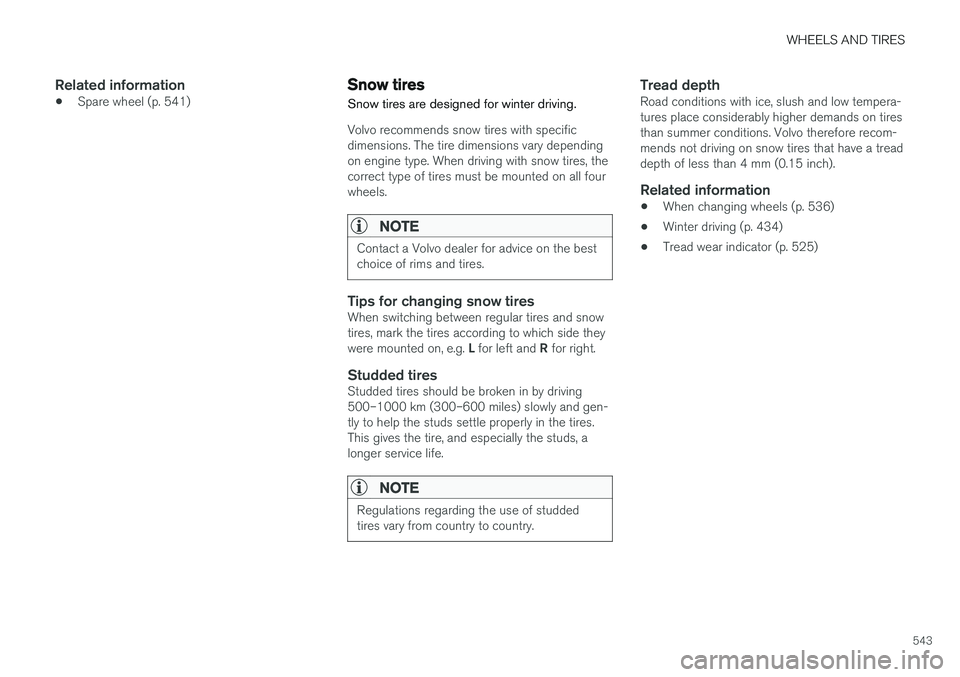
WHEELS AND TIRES
543
Related information
•Spare wheel (p. 541)
Snow tires
Snow tires are designed for winter driving.
Volvo recommends snow tires with specific dimensions. The tire dimensions vary dependingon engine type. When driving with snow tires, thecorrect type of tires must be mounted on all fourwheels.
NOTE
Contact a Volvo dealer for advice on the best choice of rims and tires.
Tips for changing snow tiresWhen switching between regular tires and snow tires, mark the tires according to which side they were mounted on, e.g. L for left and R for right.
Studded tiresStudded tires should be broken in by driving 500–1000 km (300–600 miles) slowly and gen-tly to help the studs settle properly in the tires.This gives the tire, and especially the studs, alonger service life.
NOTE
Regulations regarding the use of studded tires vary from country to country.
Tread depthRoad conditions with ice, slush and low tempera- tures place considerably higher demands on tiresthan summer conditions. Volvo therefore recom-mends not driving on snow tires that have a treaddepth of less than 4 mm (0.15 inch).
Related information
• When changing wheels (p. 536)
• Winter driving (p. 434)
• Tread wear indicator (p. 525)
Page 548 of 660
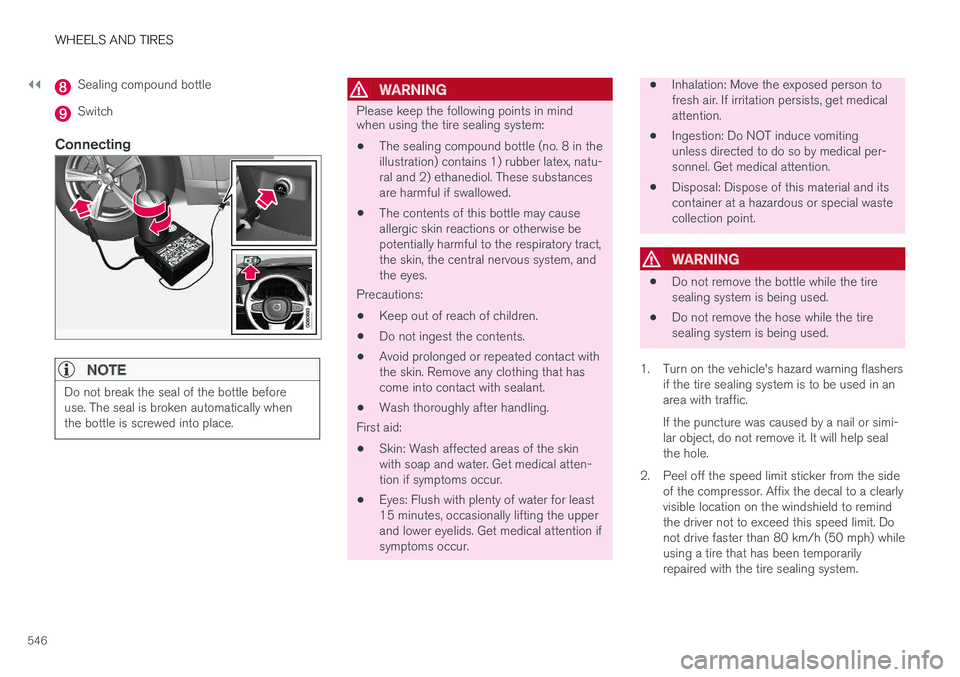
||
WHEELS AND TIRES
546
Sealing compound bottle
Switch
Connecting
NOTE
Do not break the seal of the bottle before use. The seal is broken automatically whenthe bottle is screwed into place.
WARNING
Please keep the following points in mind when using the tire sealing system:
• The sealing compound bottle (no. 8 in the illustration) contains 1) rubber latex, natu-ral and 2) ethanediol. These substancesare harmful if swallowed.
• The contents of this bottle may causeallergic skin reactions or otherwise bepotentially harmful to the respiratory tract,the skin, the central nervous system, andthe eyes.
Precautions:
• Keep out of reach of children.
• Do not ingest the contents.
• Avoid prolonged or repeated contact with the skin. Remove any clothing that has come into contact with sealant.
• Wash thoroughly after handling.
First aid: • Skin: Wash affected areas of the skin with soap and water. Get medical atten-tion if symptoms occur.
• Eyes: Flush with plenty of water for least15 minutes, occasionally lifting the upperand lower eyelids. Get medical attention ifsymptoms occur.
• Inhalation: Move the exposed person to fresh air. If irritation persists, get medicalattention.
• Ingestion: Do NOT induce vomitingunless directed to do so by medical per-sonnel. Get medical attention.
• Disposal: Dispose of this material and itscontainer at a hazardous or special wastecollection point.
WARNING
•
Do not remove the bottle while the tire sealing system is being used.
• Do not remove the hose while the tiresealing system is being used.
1. Turn on the vehicle's hazard warning flashers if the tire sealing system is to be used in anarea with traffic. If the puncture was caused by a nail or simi- lar object, do not remove it. It will help sealthe hole.
2. Peel off the speed limit sticker from the side of the compressor. Affix the decal to a clearlyvisible location on the windshield to remindthe driver not to exceed this speed limit. Donot drive faster than 80 km/h (50 mph) whileusing a tire that has been temporarilyrepaired with the tire sealing system.
Page 567 of 660
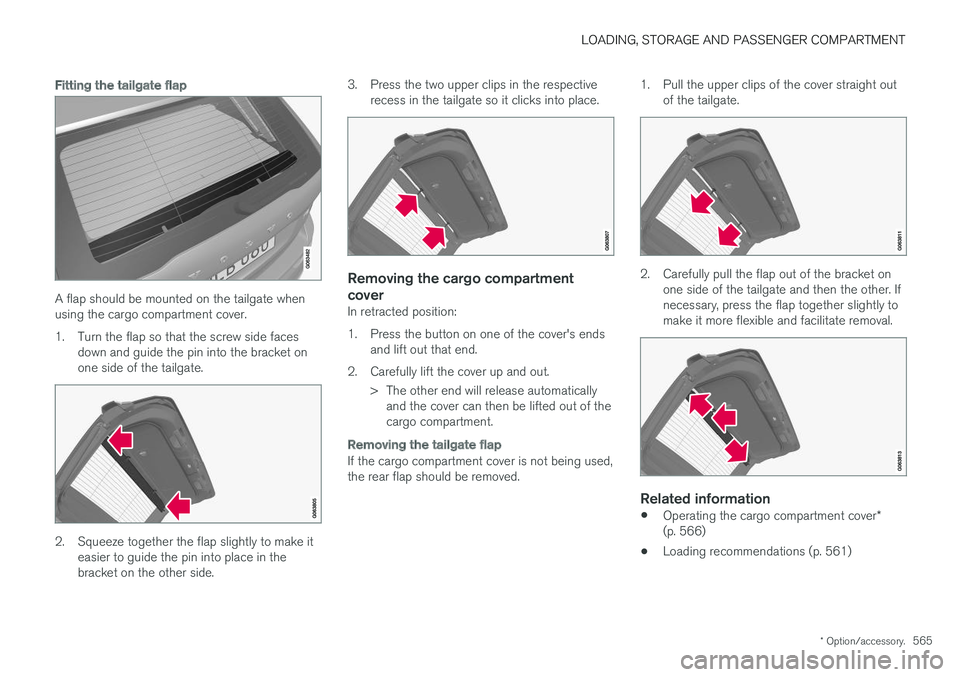
LOADING, STORAGE AND PASSENGER COMPARTMENT
* Option/accessory.565
Fitting the tailgate flap
A flap should be mounted on the tailgate when using the cargo compartment cover.
1. Turn the flap so that the screw side faces
down and guide the pin into the bracket on one side of the tailgate.
2. Squeeze together the flap slightly to make iteasier to guide the pin into place in the bracket on the other side. 3. Press the two upper clips in the respective
recess in the tailgate so it clicks into place.
Removing the cargo compartment cover
In retracted position:
1. Press the button on one of the cover's endsand lift out that end.
2. Carefully lift the cover up and out. > The other end will release automaticallyand the cover can then be lifted out of the cargo compartment.
Removing the tailgate flap
If the cargo compartment cover is not being used, the rear flap should be removed. 1. Pull the upper clips of the cover straight out
of the tailgate.
2. Carefully pull the flap out of the bracket onone side of the tailgate and then the other. If necessary, press the flap together slightly tomake it more flexible and facilitate removal.
Related information
• Operating the cargo compartment cover
*
(p. 566)
• Loading recommendations (p. 561)
Page 571 of 660
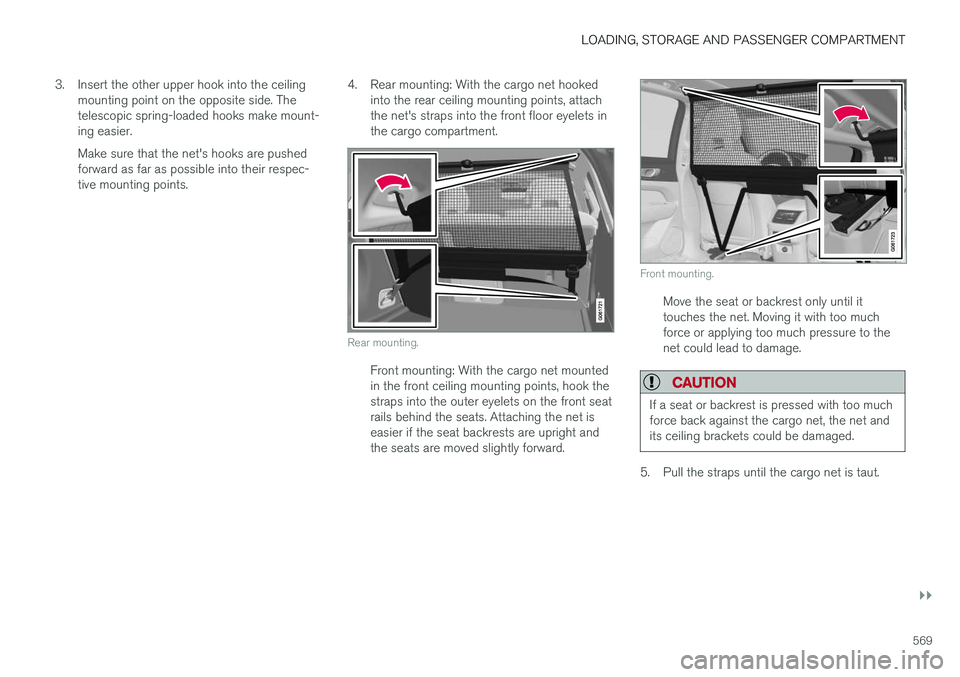
LOADING, STORAGE AND PASSENGER COMPARTMENT
}}
569
3. Insert the other upper hook into the ceiling
mounting point on the opposite side. The telescopic spring-loaded hooks make mount-ing easier. Make sure that the net's hooks are pushed forward as far as possible into their respec-tive mounting points. 4. Rear mounting: With the cargo net hooked
into the rear ceiling mounting points, attachthe net's straps into the front floor eyelets inthe cargo compartment.
Rear mounting.
Front mounting: With the cargo net mounted in the front ceiling mounting points, hook thestraps into the outer eyelets on the front seatrails behind the seats. Attaching the net iseasier if the seat backrests are upright andthe seats are moved slightly forward.
Front mounting.
Move the seat or backrest only until it touches the net. Moving it with too muchforce or applying too much pressure to thenet could lead to damage.
CAUTION
If a seat or backrest is pressed with too much force back against the cargo net, the net andits ceiling brackets could be damaged.
5. Pull the straps until the cargo net is taut.
Page 579 of 660
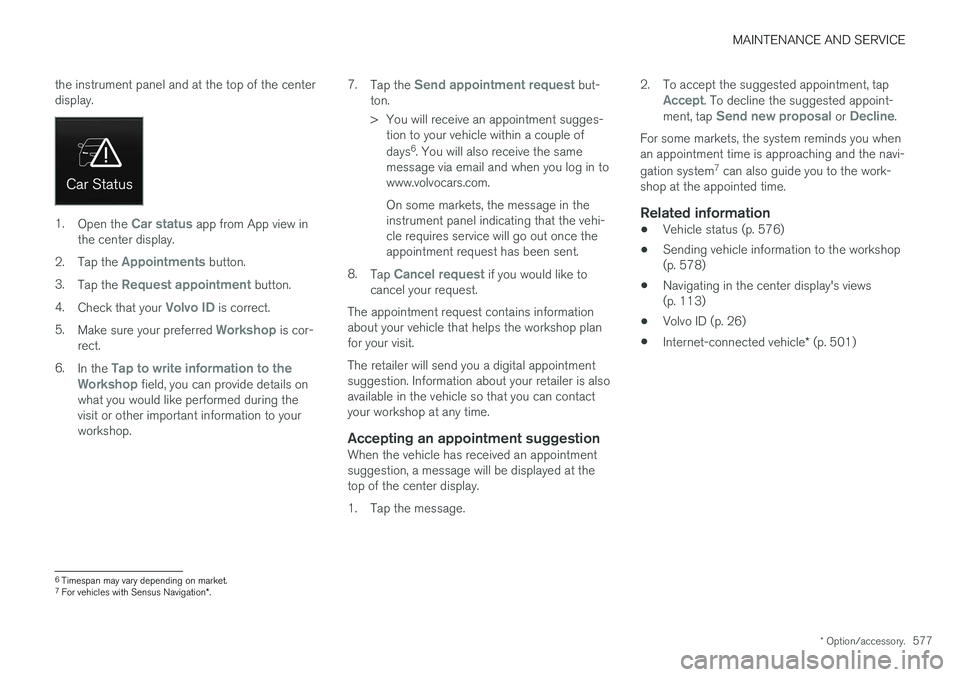
MAINTENANCE AND SERVICE
* Option/accessory.577
the instrument panel and at the top of the center display.
1.
Open the Car status app from App view in
the center display.
2. Tap the
Appointments button.
3. Tap the
Request appointment button.
4. Check that your
Volvo ID is correct.
5. Make sure your preferred
Workshop is cor-
rect.
6. In the
Tap to write information to the
Workshop field, you can provide details on
what you would like performed during the visit or other important information to yourworkshop. 7.
Tap the
Send appointment request but-
ton.
> You will receive an appointment sugges- tion to your vehicle within a couple of days 6
. You will also receive the same
message via email and when you log in to www.volvocars.com. On some markets, the message in the instrument panel indicating that the vehi-cle requires service will go out once theappointment request has been sent.
8. Tap
Cancel request if you would like to
cancel your request.
The appointment request contains information about your vehicle that helps the workshop planfor your visit. The retailer will send you a digital appointment suggestion. Information about your retailer is alsoavailable in the vehicle so that you can contactyour workshop at any time.
Accepting an appointment suggestionWhen the vehicle has received an appointmentsuggestion, a message will be displayed at thetop of the center display.
1. Tap the message. 2. To accept the suggested appointment, tap
Accept. To decline the suggested appoint-
ment, tap Send new proposal or Decline.
For some markets, the system reminds you when an appointment time is approaching and the navi- gation system 7
can also guide you to the work-
shop at the appointed time.
Related information
• Vehicle status (p. 576)
• Sending vehicle information to the workshop (p. 578)
• Navigating in the center display's views (p. 113)
• Volvo ID (p. 26)
• Internet-connected vehicle
* (p. 501)
6
Timespan may vary depending on market.
7 For vehicles with Sensus Navigation *.
Page 599 of 660
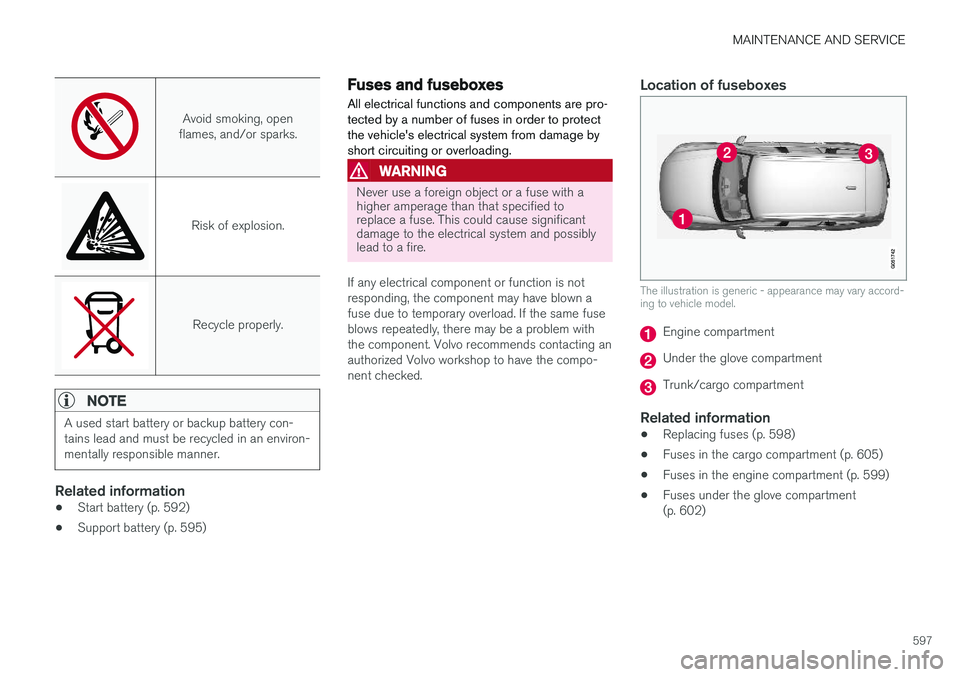
MAINTENANCE AND SERVICE
597
Avoid smoking, open
flames, and/or sparks.
Risk of explosion.
Recycle properly.
NOTE
A used start battery or backup battery con- tains lead and must be recycled in an environ-mentally responsible manner.
Related information
• Start battery (p. 592)
• Support battery (p. 595)
Fuses and fuseboxes
All electrical functions and components are pro- tected by a number of fuses in order to protectthe vehicle's electrical system from damage byshort circuiting or overloading.
WARNING
Never use a foreign object or a fuse with a higher amperage than that specified toreplace a fuse. This could cause significantdamage to the electrical system and possiblylead to a fire.
If any electrical component or function is not responding, the component may have blown afuse due to temporary overload. If the same fuseblows repeatedly, there may be a problem withthe component. Volvo recommends contacting anauthorized Volvo workshop to have the compo-nent checked.
Location of fuseboxes
The illustration is generic - appearance may vary accord- ing to vehicle model.
Engine compartment
Under the glove compartment
Trunk/cargo compartment
Related information
• Replacing fuses (p. 598)
• Fuses in the cargo compartment (p. 605)
• Fuses in the engine compartment (p. 599)
• Fuses under the glove compartment (p. 602)
Page 618 of 660
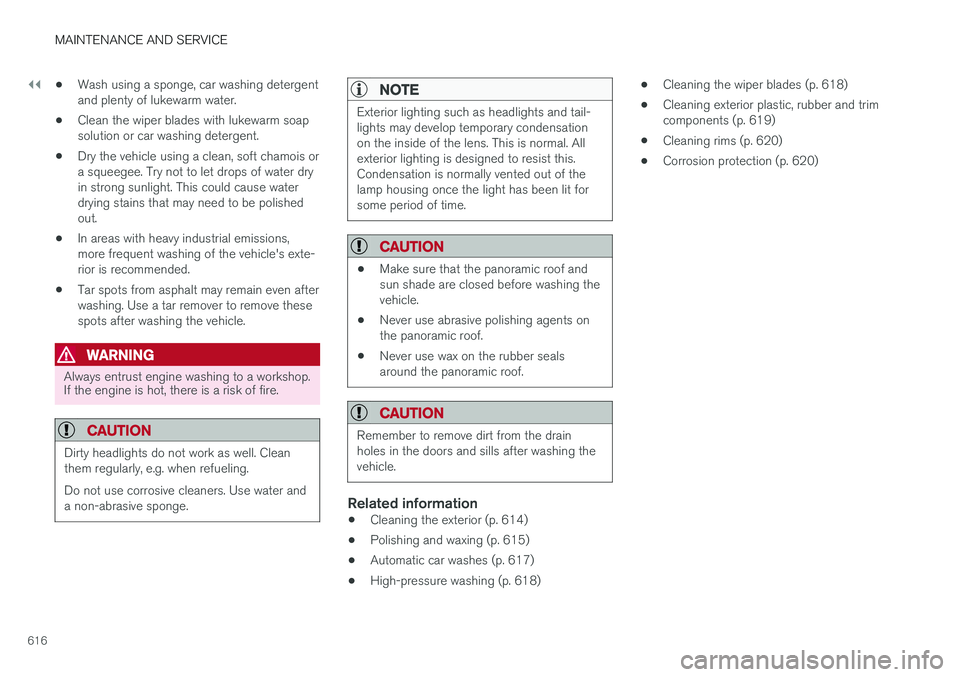
||
MAINTENANCE AND SERVICE
616•
Wash using a sponge, car washing detergent and plenty of lukewarm water.
• Clean the wiper blades with lukewarm soapsolution or car washing detergent.
• Dry the vehicle using a clean, soft chamois ora squeegee. Try not to let drops of water dryin strong sunlight. This could cause waterdrying stains that may need to be polishedout.
• In areas with heavy industrial emissions,more frequent washing of the vehicle's exte-rior is recommended.
• Tar spots from asphalt may remain even afterwashing. Use a tar remover to remove thesespots after washing the vehicle.
WARNING
Always entrust engine washing to a workshop. If the engine is hot, there is a risk of fire.
CAUTION
Dirty headlights do not work as well. Clean them regularly, e.g. when refueling. Do not use corrosive cleaners. Use water and a non-abrasive sponge.
NOTE
Exterior lighting such as headlights and tail- lights may develop temporary condensationon the inside of the lens. This is normal. Allexterior lighting is designed to resist this.Condensation is normally vented out of thelamp housing once the light has been lit forsome period of time.
CAUTION
• Make sure that the panoramic roof and sun shade are closed before washing thevehicle.
• Never use abrasive polishing agents onthe panoramic roof.
• Never use wax on the rubber sealsaround the panoramic roof.
CAUTION
Remember to remove dirt from the drain holes in the doors and sills after washing thevehicle.
Related information
• Cleaning the exterior (p. 614)
• Polishing and waxing (p. 615)
• Automatic car washes (p. 617)
• High-pressure washing (p. 618) •
Cleaning the wiper blades (p. 618)
• Cleaning exterior plastic, rubber and trim components (p. 619)
• Cleaning rims (p. 620)
• Corrosion protection (p. 620)
Page 633 of 660
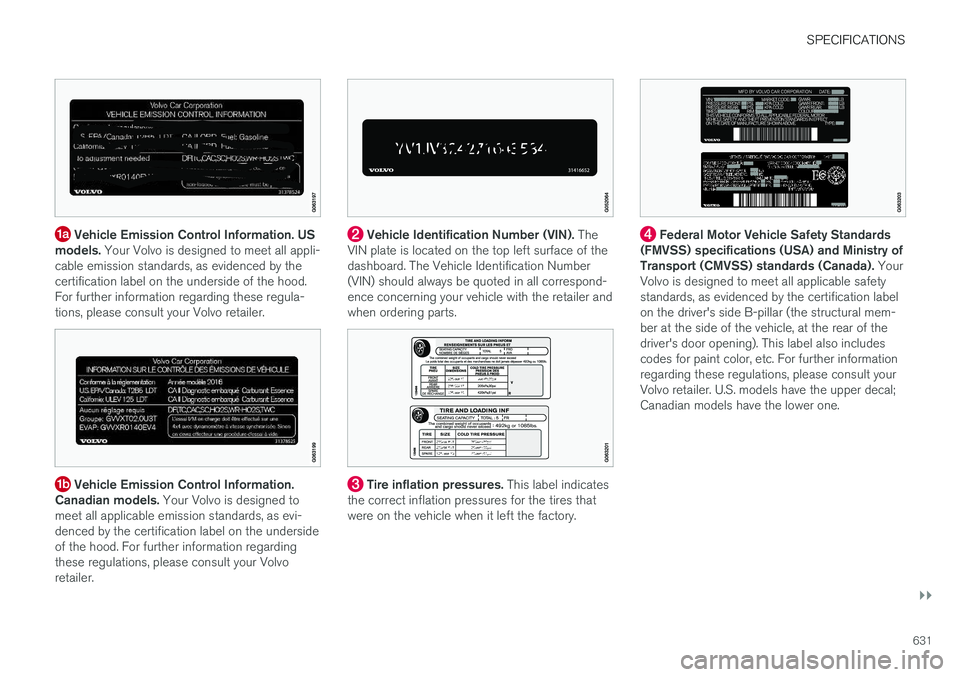
SPECIFICATIONS
}}
631
Vehicle Emission Control Information. US
models. Your Volvo is designed to meet all appli-
cable emission standards, as evidenced by the certification label on the underside of the hood.For further information regarding these regula-tions, please consult your Volvo retailer.
Vehicle Emission Control Information.
Canadian models. Your Volvo is designed to
meet all applicable emission standards, as evi- denced by the certification label on the undersideof the hood. For further information regardingthese regulations, please consult your Volvoretailer.
Vehicle Identification Number (VIN). The
VIN plate is located on the top left surface of the dashboard. The Vehicle Identification Number(VIN) should always be quoted in all correspond-ence concerning your vehicle with the retailer andwhen ordering parts.
Tire inflation pressures. This label indicates
the correct inflation pressures for the tires that were on the vehicle when it left the factory.
Federal Motor Vehicle Safety Standards
(FMVSS) specifications (USA) and Ministry of Transport (CMVSS) standards (Canada). Your
Volvo is designed to meet all applicable safetystandards, as evidenced by the certification labelon the driver's side B-pillar (the structural mem-ber at the side of the vehicle, at the rear of thedriver's door opening). This label also includescodes for paint color, etc. For further informationregarding these regulations, please consult yourVolvo retailer. U.S. models have the upper decal;Canadian models have the lower one.